There are inflatable and self-inflating sleeping pads on the market with a laminated TPU on a stretch-knit polyester, and on a woven polyester. So which is better to choose? This issue is related to the question I received recently, and it is discussed in detail here.
For inflatable and self-inflating sleeping pads, laminated and extrusion laminated TPU on a woven polyester is generally the better choice than on stretch-knit polyester. This applies to all important features like air-tightness, leak resistance, durability, weight, and packability.
Woven polyester provides a more reliable and long-lasting option for outdoor use, with fewer compromises compared to stretch-knit polyester. Stretch-knit polyester, while generally offering more comfort, falls short in these critical performance areas.

About terminology
The letters TPU here mean Thermoplastic Polyurethane, a plastic-like film used to laminate a fabric, typically polyester.
Extrusion lamination was pioneered in sleeping pads by Sea to Summit brand. This means that liquid thermoplastic urethane is applied to the face fabric through an extrusion head, where it bonds permanently, resulting in mats that are more reliable and longer-lasting.
Woven fabric is a fabric formed by weaving, i.e., by interlacing two or more threads at right angles to one another.
On the other hand, a knitted fabric is a textile that results from inter-looping of yarns or inter-meshing of loops. It is typically more flexible than a woven fabric.
When comparing laminated and extrusion laminated TPU on stretch-knit polyester versus woven polyester for inflatable and self-inflating sleeping pads, different factors must be considered. They include air-tightness, leak resistance, durability, weight, and packability. So let’s discuss these factors one by one.
1. Air-Tightness
- Woven Polyester: Woven polyester provides better air-tightness due to its tighter weave and stable structure. The TPU layer bonds more consistently to this fabric, minimizing the risk of air leaks.
- Stretch-Knit Polyester: Stretch-knit polyester is more flexible, which can put stress on the TPU layer and create potential weak points, leading to a higher risk of leaks over time.
Verdict: Woven polyester is superior in terms of air-tightness.
2. Leak Resistance
- Woven Polyester: The durability and tight weave of woven polyester make it more resistant to punctures, tears, and seam failures. This reduces the likelihood of leaks, especially in rugged outdoor conditions.
- Stretch-Knit Polyester: The stretchiness of stretch-knit polyester can cause stress at seams and around the TPU layer, making it more prone to leaks, especially with repeated use and under high pressure.
Verdict: Woven polyester offers better leak resistance.
3. Durability
- Woven Polyester: Known for its strong and abrasion-resistant properties, woven polyester holds up well against wear and tear, making it more durable in rough environments.
- Stretch-Knit Polyester: While more comfortable, stretch-knit polyester is less durable and more vulnerable to abrasions and punctures, reducing its lifespan in demanding conditions.
Verdict: Woven polyester is more durable.
4. Weight
- Woven Polyester: Generally, woven polyester is lighter because it doesn’t require as thick a structure to achieve strength and durability. This makes it a better option for those who need to minimize weight.
- Stretch-Knit Polyester: Stretch-knit polyester tends to be heavier due to its thicker, more cushioned nature, which adds extra bulk to the sleeping pad.
Verdict: Woven polyester is usually lighter.
5. Packability
- Woven Polyester: Because of its lighter weight and less bulky nature, woven polyester compresses more easily, leading to better packability. This is ideal for those needing to save space in their gear.
- Stretch-Knit Polyester: The added thickness and flexibility of stretch-knit polyester can make it harder to compress, resulting in a bulkier pack size.
Verdict: Woven polyester is more packable.
Additional Points to Consider
Seam Strength and Integrity
Woven polyester generally allows for stronger seams when joined together, as the fabric’s structure holds up well under the pressure of sealing processes, such as heat welding or adhesive bonding.
This is crucial for inflatable sleeping pads, where seams are often the first points to fail.
Stretch-knit polyester, due to its stretchy nature, can be more challenging to seal effectively, as the seams may be more prone to stretching and stress, leading to potential leaks over time.
Temperature and Environmental Factors
Woven polyester is less affected by temperature changes compared to stretch-knit polyester. In colder conditions, stretch-knit polyester may lose some of its flexibility, making it more prone to cracking or delamination of the TPU layer.
Woven polyester, with its more stable structure, tends to maintain its integrity better in varying temperatures, which is important for maintaining air-tightness in outdoor environments.
Ease of Repair
If a puncture or leak does occur, woven polyester is generally easier to repair effectively.
Patches and adhesives tend to adhere better to the more rigid surface of woven polyester compared to the more flexible and textured stretch-knit polyester. This makes field repairs more reliable and long-lasting on woven fabrics.
Long-Term Durability
Woven polyester is better equipped to handle repeated inflation, deflation, and environmental stresses without compromising air-tightness.
The extrusion laminated TPU layer remains more intact on a non-stretch fabric like woven polyester, ensuring long-term durability.
Stretch-knit polyester, due to its elastic nature, is more susceptible to wear over time, especially at stress points, leading to potential leaks.
Manufacturing Precision
During the extrusion lamination process, precision is key to ensuring that the TPU layer is evenly applied.
Woven polyester’s stable structure facilitates a more controlled and uniform application of the TPU layer, which is crucial for maintaining air-tightness.
Stretch-knit polyester, on the other hand, may present challenges in achieving this level of precision due to its inherent flexibility and surface variations.
Examples of stretch-knit and woven fabric sleeping pads
Actually, I have both types of these sleeping pads, and I have been using them in the recent months. Obviously, I know the differences between them from my own first-hand experience.
My Elegear Self Inflating Sleeping Pad is an excellent example of a stretch-knit type, the fabric is a moderately durable 50D and its R-value is exceptionally high:
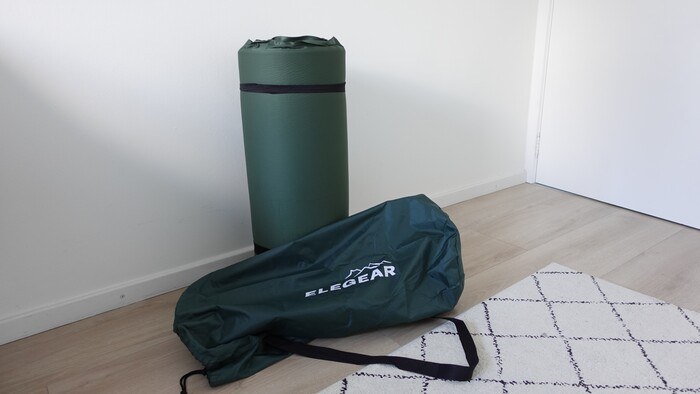
You have a stretch-knit fabric also in the Therm-a-Rest Trail Pro Sleeping Pad shown in the picture below, but they use nylon.
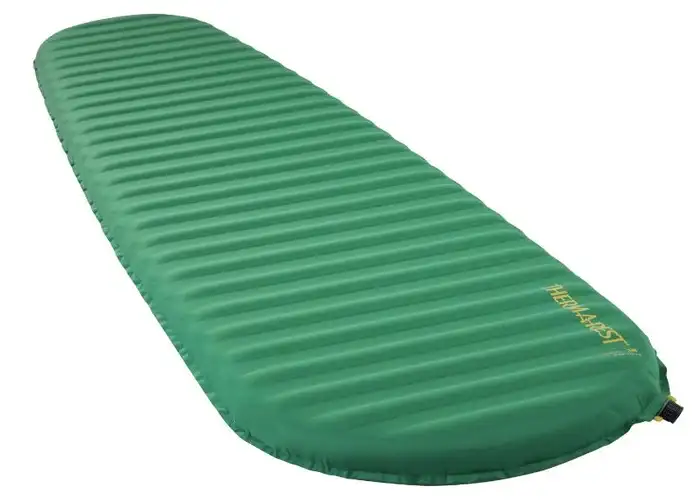
On the other hand, my Sea to Summit Camp Plus Self-Inflating Mat is made of a more durable 75D woven fabric. If you follow the link you can read all about it in detail.
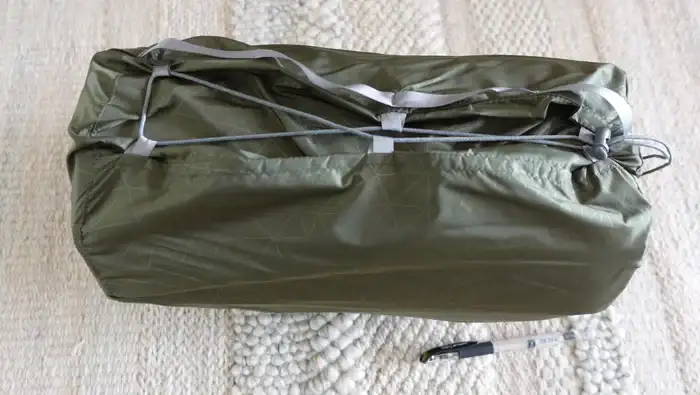
In the picture below you can see how it looks, this is the rectangular regular-wide version which I use, but they have it in several sizes and shapes.
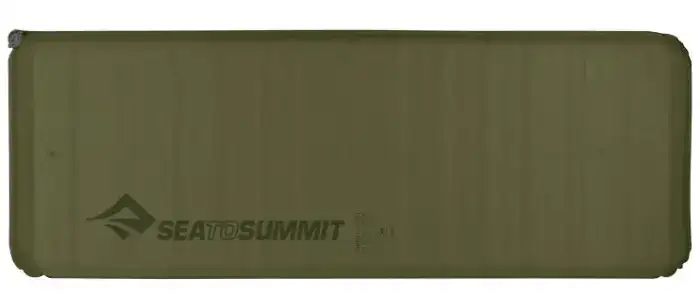
But the same brand has its Sea to Summit Comfort Plus SI pad which is with the same features, but made of a stretch-knit polyester. This fabric is behind the word Comfort in the name of the pad shown in the picture:
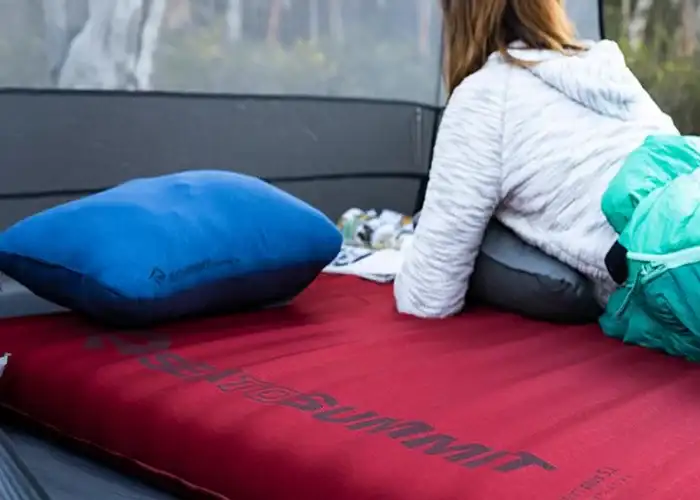
Final thoughts
In conclusion, inflatable and self-inflating sleeping pads often face tough conditions in outdoor environment, including sharp objects, rough terrain, and varying temperatures.
For these types of sleeping pads, woven polyester with laminated and extrusion laminated TPU is the better choice in terms of air-tightness, durability, and resistance to leaks.
Its stable structure provides a strong, consistent bond with the TPU layer, making it more reliable for long-term use, particularly in outdoor environments where durability and leak prevention are critical.
On the other hand, a stretch-knit polyester may offer more comfort, but it might not perform as well under these demanding conditions.
For more texts of this type, please check under the category FAQs. In particular, check my formal comparison between the Camp Plus and Comfort Plus self-inflating pads from Sea to Summit, and about warmth of a sleeping pad.
This site is all about mountaineering and outdoor activities, so bookmark it and keep as a reference. Thank you for reading. I wish you a nice day.
Leave a Reply